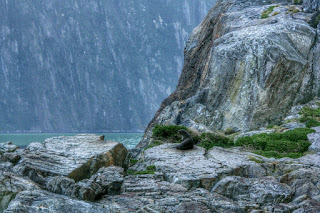A route from Wakatipu (Queenstown) to Milford was investigated by two brave explorers - both teachers - Talbot and Grave, in the early 20th century. Over a period of 15 days, on 13 of which it rained, they laid out a route suitable for tourists to visit Milford. They must have imagined some intrepid and well-seasoned tourists, as the route would take them over a pass with a sheer drop on the far side! Subsequently, construction of a route suitable for cars was started during the Great Depression, which followed a proposed route set out by Henry Homer years before, and necessitated tunneling through the same rock over which Grave and Talbot climbed - now known as Homer's Tunnel.
 |
| Pass after Homer's Tunnel |
The tunnel took a couple of decades to carve through solid granite and the road was eventually sealed in the 1980s and now sees substantial tourist traffic from coach operators to self-driven tourists fresh off the plane in Queenstown. The trouble with the latter is that many tourists arrive with little experience of driving such winding roads - or of driving full stop, as some have only just gained their licence - and present a danger to themselves and other road users. We witnessed just such an incident today, as a fire engine raced past us and our driver nodded knowingly, having seen almost one accident per day at the height of the summer on this particular stretch. Today's was a single-vehicle accident, in which the driver hit a corner travelling too fast, panicked and hit the brakes, rolling the car. The occupants were airlifted out. I was glad we had not driven ourselves.
 |
| Setting sail on the sound |
The natural phenomenon was originally named after Milford Haven but later mistakenly renamed to Milford Sound. Coming from the Norse, sund, a sound is more often used to denote an inlet created by a river, whereas fjords (or fiords) are created through glacial erosion. Milford is a fjord, hewn out of the rock by three glaciers, leaving towering cliff faces on either side of a blue body of water leading out to the Tasman Sea.
 |
| Stunning vistas |
We cruised leisurely up the fjord and into the open sea, where it became apparent how Cook had missed this feature on each of his three circumnavigations of New Zealand.
 |
| Waterfalls |
The mouth of the fjord is small and easily mistaken for a river. The weather obliged us with blue skies as we visited the year-round flowing waterfalls and local seal colony hanging out on a rock.
 |
| Seals |
Lunch was an apparently home-made affair comprising a sandwich, cheese and biscuits, a cookie, flapjack and fruit.
 |
| A veritable feast |
Back on dry land, we paid a visit on our return leg to Gunn's Camp down the Hollyford track. This campsite is the only privately owned area in the Milford national park and preserves the original 1930s camp for those involved in building a road between Fiordland and Haast. Although started around the same time as the Milford toad, construction was halted during WWII and was never restarted.
 |
| Unfinished business |
Late afternoon sunshine attempted to warm the cold air - snow is predicted! - and we sat for a while at the Great Views park planning our next few days' movements along the Scenic Southern Route.
 |
| The "Great View" at Great Views |
Brr. The evenings are certainly coming in chilly these days. I'm not sure I approve of this - it certainly makes camping more arduous, running hunched from kitchen to toilets and back to the van. This evening was the first time we employed the electric heater supplied with the van - a luxury we can afford ourselves on a powered site.
 |
| Squeezing out the flavour |
A cold evening required a hearty meal, so K prepared a vegetarian pasta bolognese from tomatoes, courgettes, onions and lentils, squashing the ripe tomatoes between her fingers in true Italian style.
No comments:
Post a Comment